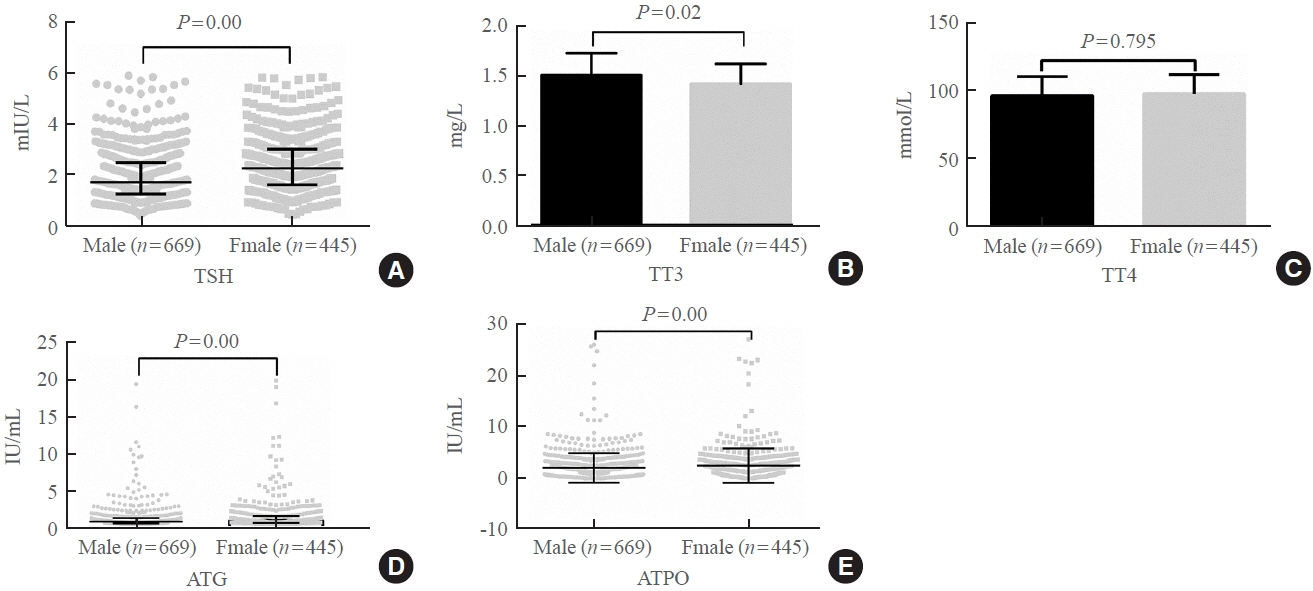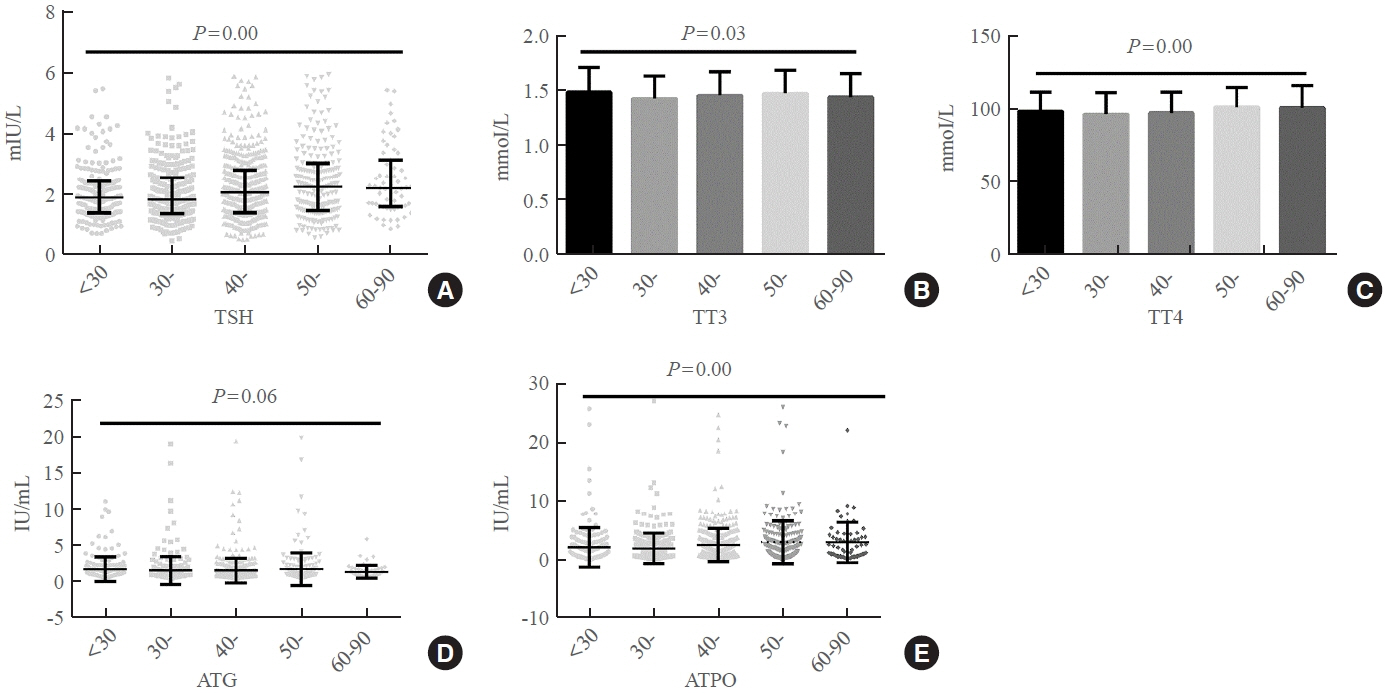Endocrinol Metab.
2023 Jun;38(3):347-356. 10.3803/EnM.2023.1638.
Thyroid Hormone Reference Intervals among Healthy Individuals In Lanzhou, China
- Affiliations
-
- 1Department of Clinical Laboratory, Gansu Provincial Hospital, Lanzhou, China
- 2Physical Examination Center, Gansu Provincial Hospital, Lanzhou, China
- 3Department of Radiology, Gansu Provincial Hospital, Lanzhou, China
- KMID: 2543321
- DOI: http://doi.org/10.3803/EnM.2023.1638
Abstract
- Background
The common reference intervals (RIs) for thyroid hormones currently used in China are provided by equipment manufacturers. This study aimed to establish thyroid hormone RIs in the population of Lanzhou, a city in the subplateau region of northwest China, and compare them with previous reports and manufacturer-provided values.
Methods
In total, 3,123 individuals (1,680 men, 1,443 women) from Lanzhou, an iodine-adequate area of China, perceived as healthy were selected. The Abbott Architect analyzer was used to determine the serum concentration of thyroid hormones. The 95% RI was estimated using the 2.5th and 97.5th percentiles as the lower and upper reference limits, respectively.
Results
The serum levels of thyroid-stimulating hormone (TSH), total triiodothyronine (TT3), antithyroglobulin (ATG) antibody, and antithyroid peroxidase (ATPO) antibody levels were significantly correlated with sex (P<0.05). TSH, total thyroxine (TT4), and ATPO levels were significantly correlated with age (P<0.05). The serum levels of TSH, ATG, and ATPO in men were significantly lower than in women; in contrast, the serum TT3 level was significantly higher in men than in women (P<0.05). Serum TSH, TT3, TT4, and ATG levels differed across age groups (P<0.05), but no such variation was observed for ATG levels (P>0.05). The established RIs of TSH, ATG, and ATPO in this study differed between sexes (P<0.05). The thyroid hormone RIs established herein were inconsistent with the manufacturer-provided values.
Conclusion
The RIs of thyroid hormones in the healthy population of Lanzhou were inconsistent with those in the manufacturer’s manual. Validated sex-specific values are required for diagnosing thyroid diseases.
Keyword
Figure
Reference
-
1. Evron JM, Papaleontiou M. Decision making in subclinical thyroid disease. Med Clin North Am. 2021; 105:1033–45.
Article2. Ortiga-Carvalho TM, Chiamolera MI, Pazos-Moura CC, Wondisford FE. Hypothalamus-pituitary-thyroid axis. Compr Physiol. 2016; 6:1387–428.3. Babic Leko M, Gunjaca I, Pleic N, Zemunik T. Environmental factors affecting thyroid-stimulating hormone and thyroid hormone levels. Int J Mol Sci. 2021; 22:6521.
Article4. Liu Y, Shan Z; Endocrine Metabolic Diseases Group of the Chinese Geriatrics Society; Thyroid Group of the Chinese Society of Endocrinology, Chinese Medical Association. Expert consensus on diagnosis and treatment for elderly with thyroid diseases in China (2021). Aging Med (Milton). 2021; 4:70–92.
Article5. Biondi B, Cappola AR, Cooper DS. Subclinical hypothyroidism: a review. JAMA. 2019; 322:153–60.6. Esfandiari NH, Papaleontiou M. Biochemical testing in thyroid disorders. Endocrinol Metab Clin North Am. 2017; 46:631–48.
Article7. Wang Q, Shangguan J, Zhang Y, Pan Y, Yuan Y, Que W. The prevalence of thyroid autoantibodies in autoimmune connective tissue diseases: a systematic review and meta-analysis. Expert Rev Clin Immunol. 2020; 16:923–30.
Article8. Han L, Zheng W, Zhai Y, Xie X, Zhang J, Zhang S, et al. Reference intervals of trimester-specific thyroid stimulating hormone and free thyroxine in Chinese women established by experimental and statistical methods. J Clin Lab Anal. 2018; 32:e22344.
Article9. Xiong J, Liu S, Hu K, Xiong Y, Wang P, Xiong L. Study of reference intervals for free triiodothyronine, free thyroxine, and thyroid-stimulating hormone in an elderly Chinese Han population. PLoS One. 2020; 15:e0239579.10. Xie T, Su M, Feng J, Pan X, Wang C, Tang T. The reference intervals for thyroid hormones: a four year investigation in Chinese population. Front Endocrinol (Lausanne). 2023; 13:1046381.
Article11. Jonklaas J, Razvi S. Reference intervals in the diagnosis of thyroid dysfunction: treating patients not numbers. Lancet Diabetes Endocrinol. 2019; 7:473–83.
Article12. Li ZZ, Yu BZ, Wang JL, Yang Q, Ming J, Tang YR. Reference intervals for thyroid-stimulating hormone and thyroid hormones using the access TSH 3rd IS method in China. J Clin Lab Anal. 2020; 34:e23197.
Article13. Wang X, Li Y, Zhai X, Wang H, Zhang F, Gao X, et al. Reference intervals for serum thyroid-stimulating hormone based on a recent nationwide cross-sectional study and meta-analysis. Front Endocrinol (Lausanne). 2021; 12:660277.
Article14. Liu T, Li Y, Teng D, Shi X, Yan L, Yang J, et al. The characteristics of iodine nutrition status in china after 20 years of universal salt iodization: an epidemiology study covering 31 provinces. Thyroid. 2021; 31:1858–67.
Article15. Lu Y, Yue JY, Li DH, Zhou SH. To establish reference interval for serum thyroid hormone in adults of subaltitude determined by indirect method. Int J Lab Med. 2018; 39:2832–41.16. Jones GR, Haeckel R, Loh TP, Sikaris K, Streichert T, Katayev A, et al. Indirect methods for reference interval determination: review and recommendations. Clin Chem Lab Med. 2018; 57:20–9.17. Zierk J, Baum H, Bertram A, Boeker M, Buchwald A, Cario H, et al. High-resolution pediatric reference intervals for 15 biochemical analytes described using fractional polynomials. Clin Chem Lab Med. 2021; 59:1267–78.
Article18. Wang Y, Zhang YX, Zhou YL, Xia J. Establishment of reference intervals for serum thyroid-stimulating hormone, free and total thyroxine, and free and total triiodothyronine for the Beckman Coulter DxI-800 analyzers by indirect method using data obtained from Chinese population in Zhejiang Province, China. J Clin Lab Anal. 2017; 31:e22069.19. Ma C, Wang X, Xia L, Cheng X, Qiu L. Effect of sample size and the traditional parametric, nonparametric, and robust methods on the establishment of reference intervals: Evidence from real world data. Clin Biochem. 2021; 92:67–70.
Article20. Oron T, Lazar L, Feldhamer I, Manor M, Koren-Morag N, Tenenbaum A, et al. Pediatric reference values of TSH should be personalized according to BMI and ethnicity. Eur J Endocrinol. 2020; 183:419–26.
Article21. Adhami M, Michail P, Rao A, Bhatt CR, Grodski S, Serpell JW, et al. Anti-thyroid antibodies and TSH as potential markers of thyroid carcinoma and aggressive behavior in patients with indeterminate fine-needle aspiration cytology. World J Surg. 2020; 44:363–70.
Article22. Goundan PN, Lee SL. Lack of a threshold size for autonomously functioning thyroid nodules that excludes hyperthyroidism. Endocr Pract. 2019; 25:1263–7.
Article23. Sun Q, Avallone L, Stolze B, Araque KA, Ozarda Y, Jonklaas J, et al. Demonstration of reciprocal diurnal variation in human serum T3 and rT3 concentration demonstrated by mass spectrometric analysis and establishment of thyroid hormone reference intervals. Ther Adv Endocrinol Metab. 2020; 11:2042018820922688.
Article24. Zou Y, Wang D, Cheng X, Ma C, Lin S, Hu Y, et al. Reference intervals for thyroid-associated hormones and the prevalence of thyroid diseases in the Chinese population. Ann Lab Med. 2021; 41:77–85.
Article25. von Wolff M, Nakas CT, Tobler M, Merz TM, Hilty MP, Veldhuis JD, et al. Adrenal, thyroid and gonadal axes are affected at high altitude. Endocr Connect. 2018; 7:1081–9.
Article26. Nepal O, Pokhrel BR, Khanal K, Gyawali P, Malik SL, Koju R, et al. Thyroid hormone levels in highlanders- a comparison between residents of two altitudes in Nepal. Kathmandu Univ Med J (KUMJ). 2013; 11:18–21.
Article27. Li Y, Teng D, Ba J, Chen B, Du J, He L, et al. Efficacy and safety of long-term universal salt iodization on thyroid disorders: epidemiological evidence from 31 provinces of Mainland China. Thyroid. 2020; 30:568–79.
Article28. Barth JH, Luvai A, Jassam N, Mbagaya W, Kilpatrick ES, Narayanan D, et al. Comparison of method-related reference intervals for thyroid hormones: studies from a prospective reference population and a literature review. Ann Clin Biochem. 2018; 55:107–12.
Article29. Xing D, Liu D, Li R, Zhou Q, Xu J. Factors influencing the reference interval of thyroid-stimulating hormone in healthy adults: a systematic review and meta-analysis. Clin Endocrinol (Oxf). 2021; 95:378–89.
Article30. Ho CK, Tan ET, Ng MJ, Yeo GS, Chern B, Tee NW, et al. Gestational age-specific reference intervals for serum thyroid hormone levels in a multi-ethnic population. Clin Chem Lab Med. 2017; 55:1777–88.
Article31. Lee S, Ong CM, Zhang Y, Wu AH. Narrowed reference intervals for complete blood count in a multiethnic population. Clin Chem Lab Med. 2019; 57:1382–7.
Article32. Kwon H, Kim WG, Jeon MJ, Han M, Kim M, Park S, et al. Age-specific reference interval of serum TSH levels is high in adolescence in an iodine excess area: Korea national health and nutrition examination survey data. Endocrine. 2017; 57:445–54.
Article33. Yoshihara A, Noh JY, Ohye H, Sato S, Sekiya K, Kosuga Y, et al. Reference limits for serum thyrotropin in a Japanese population. Endocr J. 2011; 58:585–8.34. Sarkar R. Non-transference of biological reference interval of TSH by electrochemiluminescence immunoassay: an Indian population perspective. Clin Chim Acta. 2013; 423:130–4.
Article35. Yildiz Z, Dagdelen LK. Reference intervals for thyroid disorders calculated by indirect method and comparison with reference change values. Biochem Med (Zagreb). 2023; 33:010704.
Article36. Hickman PE, Koerbin G, Simpson A, Potter JM, Hughes DG, Abhayaratna WP, et al. Using a thyroid disease-free population to define the reference interval for TSH and free T4 on the Abbott Architect analyser. Clin Endocrinol (Oxf). 2017; 86:108–12.
Article37. Hollowell JG, Staehling NW, Flanders WD, Hannon WH, Gunter EW, Spencer CA, et al. Serum TSH, T(4), and thyroid antibodies in the United States population (1988 to 1994): National Health and Nutrition Examination Survey (NHANES III). J Clin Endocrinol Metab. 2002; 87:489–99.38. Gurgel MH, Ponte CM, Fontes R, Rocha IV, Batista LA, Sousa TC, et al. Establishment of reference interval for thyroid-stimulating hormone using electrochemiluminescence assay in a healthy adult population from Fortaleza, Brazil. Arch Endocrinol Metab. 2020; 64:362–8.39. Larisch R, Giacobino A, Eckl W, Wahl HG, Midgley JE, Hoermann R. Reference range for thyrotropin: post hoc assessment. Nuklearmedizin. 2015; 54:112–7.40. Reix N, Massart C, d’Herbomez M, Gasser F, Heurtault B, Agin A. Thyroid-stimulating hormone and free thyroxine on the ADVIA Centaur immunoassay system: a multicenter assessment of analytical performance. Clin Biochem. 2013; 46:1305–8.
Article41. Javaid U, Kennedy D, Addison C, Tsatlidis V, Razvi S. Frequency, determinants and costs of thyroid function testing in a laboratory serving a large population. Eur J Endocrinol. 2022; 186:553–60.
Article42. Clerico A, Trenti T, Aloe R, Dittadi R, Rizzardi S, Migliardi M, et al. A multicenter study for the evaluation of the reference interval for TSH in Italy (ELAS TSH Italian Study). Clin Chem Lab Med. 2018; 57:259–67.
Article43. Bohn MK, Higgins V, Asgari S, Leung F, Hoffman B, Macri J, et al. Paediatric reference intervals for 17 Roche cobas 8000 e602 immunoassays in the CALIPER cohort of healthy children and adolescents. Clin Chem Lab Med. 2019; 57:1968–79.
Article44. Musa IR, Ali NI, Elseed SA, Osman OE, Adam I. Reference intervals of thyroid hormones in Khartoum, Sudan. BMC Res Notes. 2018; 11:729.
Article45. Kahapola-Arachchige KM, Hadlow N, Wardrop R, Lim EM, Walsh JP. Age-specific TSH reference ranges have minimal impact on the diagnosis of thyroid dysfunction. Clin Endocrinol (Oxf). 2012; 77:773–9.
Article46. Wang D, Yu S, Ma C, Li H, Qiu L, Cheng X, et al. Reference intervals for thyroid-stimulating hormone, free thyroxine, and free triiodothyronine in elderly Chinese persons. Clin Chem Lab Med. 2019; 57:1044–52.
Article47. Fontes R, Teixeira Pde F, Vaisman M. Screening of undiagnosed hypothyroidism in elderly persons with diabetes according to age-specific reference intervals for serum thyroid stimulating hormone and the impact of antidiabetes drugs. J Diabetes Res. 2016; 2016:1417408.
Article
- Full Text Links
- Actions
-
Cited
- CITED
-
- Close
- Share
- Similar articles
-
- Establishing Reference Intervals for Complete Blood Cell Count in Healthy Korean Elderly Individuals
- TSH and Free T4 Concentrations in Korean Pregnant Women
- Reference Intervals for Thyroid-Associated Hormones and the Prevalence of Thyroid Diseases in the Chinese Population
- Reference intervals of thyroid hormones during pregnancy in Korea, an iodine-replete area
- Subclinical Thyroid Dysfunction in the Elderly



